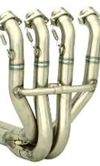Exhaust Manufacture: Future directions
 For those of you following the ‘Focus’ articles in Race Engine Technology magazine, it is clear that recent changes and improvements in manufacturing technology have improved the products being examined, and this is undoubtedly true for most machined parts, and also for parts produced by casting and forging too. Clearly the CNC revolution has not left the world of fabrication untouched with many operations controlled by computer being more accurate than the average man could ever be. We will not include those who make motorsport exhausts as ‘the average man’. Thankfully, we are a long way from being able to replace these craftsmen by robots. However, they do benefit from more accurate bends being available for them to craft their exhausts from, and pressed bends and irregular sections formed by CNC-machined punches, dies and moulds. This has been true for some time, so we might ask if we are finished with manufacturing advances for exhausts.
For those of you following the ‘Focus’ articles in Race Engine Technology magazine, it is clear that recent changes and improvements in manufacturing technology have improved the products being examined, and this is undoubtedly true for most machined parts, and also for parts produced by casting and forging too. Clearly the CNC revolution has not left the world of fabrication untouched with many operations controlled by computer being more accurate than the average man could ever be. We will not include those who make motorsport exhausts as ‘the average man’. Thankfully, we are a long way from being able to replace these craftsmen by robots. However, they do benefit from more accurate bends being available for them to craft their exhausts from, and pressed bends and irregular sections formed by CNC-machined punches, dies and moulds. This has been true for some time, so we might ask if we are finished with manufacturing advances for exhausts.
The simple answer is that we are definitely not finished. The advent of ‘direct metal laser sintering’ and other ‘additive’ manufacturing technologies can offer us the possibility to make shapes and sections of exhausts which would either be extremely difficult or impossible to make by hand. These are essentially ‘traditional’ rapid prototyping technologies applied to metallic parts to produce functional parts. The quality of the process, the improvements in surface finish and the strength and density of parts is vastly superior to the state of this technology just five years ago, and it is rapidly becoming widely accessible, albeit at a cost.
It gives us the chance to put proper fillets in places where welding is difficult and so it may offer us the chance to finally cure that collector that keeps cracking. Where a number of pipes meet at a shallow angle, it is inevitable that there is a severe stress concentration where the pipes meet, because it is difficult or impossible to weld between each pipe. Examining such geometry on a small scale, we have manufactured a ‘crack’ at each junction. The fabricator may through his skill be able to reach in to melt the sharp edge sufficiently to mitigate this problem, but in DMLS and other technologies we have the chance to define the exact geometry that we want and in the process eliminate the stress concentration.
It is obvious that this technology offers us the chance to also make other exhaust parts which are either impossible to make by other means, or very risky owing to the difficulty in manufacture and weld access. In a recent Formula One exhaust project that I was involved with, we experimented with different internal configurations in a collector with the same basic dimensions in terms of tube size, angles, positions etc. There is certainly a clear effect on the engine from these changes, but there were many configurations where the collector would have been too risky to run even at a test session; race use was definitely out of the question owing to problems with durability. Some of the parts were just too difficult to make using conventional techniques. The ‘rapid prototype’ approach would go some way toward solving these problems, especially as high-temperature materials are among those available.
Written by Wayne Ward.